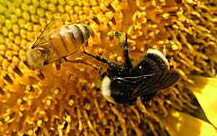One of the practices that many modern cultivation mutualists (that is, farmers) do to help their crops grow is provide domesticated honeybees to pollinate them. The bees flit from male to female flowers, carrying pollen between them. Without such pollination, crops like hybrid sunflowers, grown for their seed, would fail.

A study [found here] by Sarah S. Greenleaf of Princeton and Claire Kremen of the University of California, Berkeley, demonstrates one factor that can improve the efficiency of honeybee pollinators: the presence of wild bees.
The researchers studied hybrid sunflower fields in the northern part of the California Central Valley. The study sites were near natural areas that are home to wild bees. They measured factors like the number of bee visits to a flower and the pollination efficiency – how many fertile sunflower seeds were produced in a flower head after a visit by a single bee. The findings were published in The Proceedings of the National Academy of Sciences.
The researchers found that in fields with both wild and domesticated bees, pollination efficiency was up to five times as high as that in fields without wild bees.
It’s not that the wild bees did all that much pollinating themselves; rather, the researchers say, they affected the behavior of the honeybees. A honeybee collecting pollen on a male flower may be disturbed by the approach of a wild bee (particularly if the wild bee is looking for a mate) and buzz off to a nearby female flower, leading to pollination.
More in-depth coverage of this story here.
